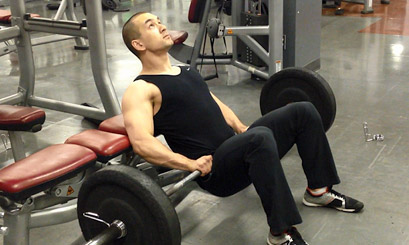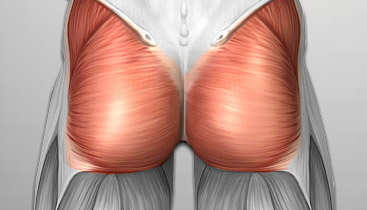BEST GLUTE EXERCISES FOR MASS: THE BARBELL HIP THRUST

While basic lower body compound exercises such as squats, deadlifts, leg presses and lunges do train the glutes effectively on their own, direct glute training is still necessary if you’re wanting to build these muscles up to their maximum size and strength potential.
That’s because the standard leg exercises used in most bodybuilding programs don’t allow for full extension of the hip joint, which is the primary function of the gluteus maximus.
Squatting down to parallel, performing a leg press, or cranking out a set of Romanian deadlifts does engage the glutes through this function to a degree, but not through the full range of motion that they’re truly capable of.
The benefits of direct glute training also extend beyond just improving their overall size, strength and appearance, and also includes added bonuses such as increased sprinting speed and explosiveness, improved squatting strength, increased deadlift lockout power and just better all-around total-body functioning.

So, what are the best glute exercises to help you accomplish this?
While there are many different movements you could use to directly target the glutes for increased size, strength and functioning, today I’ll be sharing with you what is widely regarded as the #1 glute exercise in existence, and the one that I suggest using as the primary movement in any glute-training routine…
That exercise is the hip thrust.
Physique competitors and professional athletes have long known about the benefits of hip thrusting for building up their glutes and developing overall speed, strength and power, and in today’s post I’m going to show you how to take advantage of this exercise as well.
Yes, you might feel slightly embarrassed performing this lift at first (I usually get at least one puzzled/amused look from someone at the gym every time I do these), but if reaching your training goals in the most effective manner is more important to you than a few awkward stares, this is the lift you need to be doing for your glutes.
Hip thrusts place your body into the most advantageous position in order to achieve full hip extension and to get the deepest contraction of the glutes possible.

They also allow you to accomplish this without the lower back becoming a limiting factor in the movement.
On top of this, hip thrusts also train the quads, hamstrings and adductors to a degree as well, so you’ll be getting multiple benefits beyond just direct glute stimulation.
There are an almost endless number of different hip thrusting variations that can be done using different angles, training tools and either double or single-legged, but today I’ll be showing you how to perform the most commonly used version and the one that I typically recommend first, which is the basic barbell hip thrust.
Best Glute Exercises: Proper Barbell Hip Thrust Form
Proper form on this exercise is extremely important to ensure that it’s your glutes that are performing the bulk of the work, and to minimize the stress on your lower back as well.
Many people make a ton of basic errors on the barbell hip thrust that greatly reduce its effectiveness, so make sure that you understand and practice correct technique on these to get the very most out of the exercise.
Here’s how to go about it…
1) Sit perpendicular against a flat bench and roll a loaded barbell into the crease of your hips.
If you aren’t strong enough to perform hip thrusts with a 45 pound plate on each side, there likely won’t be enough space for you to roll the bar in. In that case, you can either use a training partner to help you place the bar there, or you can lift the bar up off the ground and get into a seated position on the bench, lowering yourself down from there.
2) Position your feet about shoulder width apart or slightly wider, with your toes pointing straight head or just slightly outward.
The specific distance that you place your feet away from the bench will depend on your individual body structure, and your goal should be to find whatever distance causes your shins to be either vertical or just slightly angled backward once you reach full hip extension at the top of the movement.
3) Once you find your initial starting position, use your elbows to press your hips up and move the bar off the ground. Grab the bar using an overhand grip just outside of your hips and wedge your mid-back into the bench.
If you’re just starting out with this exercise then you’ll likely find it quite uncomfortable to have the bar directly pressing against your hips, in which case you’ll want to place a pad or towel around the bar. However, you’ll likely find that after several weeks of consistent hip thrusting the discomfort will subside as your body gets used to it.
4) With a neutral head position (imagine there’s an egg underneath your chin that you don’t want to break), chest and ribcage flat (not puffed out) and lower back neutral (rather than arched), press through your heels and drive yourself up until your hips are fully extended and your torso is parallel to ground.
Always make sure to drive the weight up under smooth control without any jerky movements or excessive momentum.
5) Really focus on engaging your glutes at all times rather than your back or your hamstings. Once you reach the top of the movement, pause briefly and consciously contract your glutes with force.
6) Lower yourself back down under control. You can either go all the way down until the plates touch the floor, or stop mid-air before performing your next rep. This will vary from person to person and you’ll need to test out which approach feels best for you.
Everyone’s body is different, so you’ll want to experiment with different foot positioning, placing your back higher or lower on the bench, and using a larger or smaller range of motion to find the specific barbell hip thrust variation that maximizes glute stimulation and minimizes lower back stress for you.
If this is a new exercise for you, always start off very light and gradually work your way up. If you don’t feel a strong contraction in your glutes when performing your barbell hip thrusts, or if you aren’t able to rise up into full hip extension, then the weight is either too heavy for you or you aren’t using proper technique.
Focus on training your glutes here, not your ego.
Once you nail down the proper form for yourself you’ll be able to add weight to the exercise fairly quickly, but make sure you’re doing it correctly right from the start so that you don’t develop any bad habits.
You can do this exercise anywhere from 1-3 times per week at the end of your leg workouts, for 3-4 sets of anywhere from 5-12 reps.
A barbell hip thrust is not a mandatory exercise that everyone must include in their training routine, but if building up the size and strength of your glutes is something you’re specifically aiming for, this one is at the very top on the list of best glute exercises and is simply the most effective method of direct glute training there is.
If you found this article helpful, make sure to sign up for your FREE custom fitness plan below...




